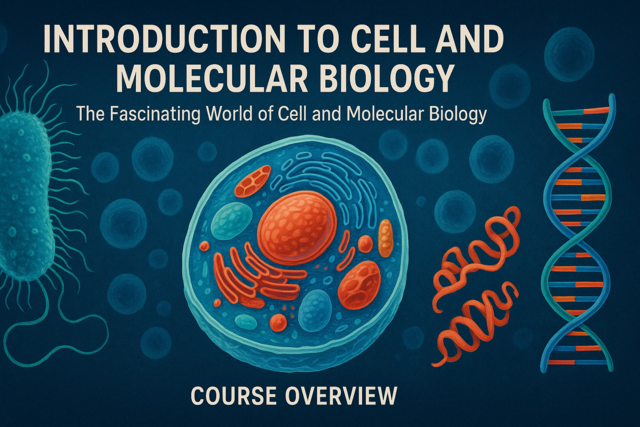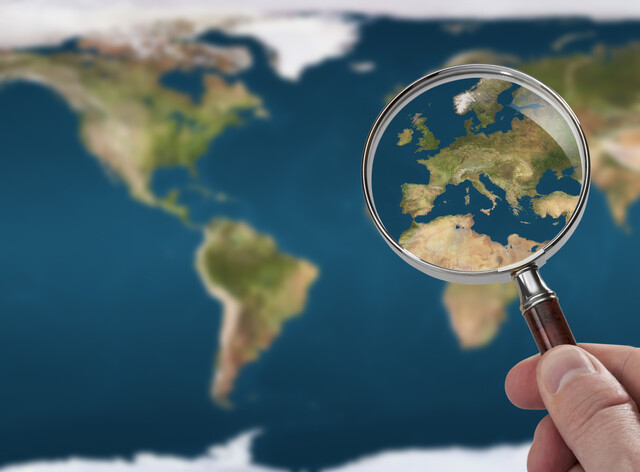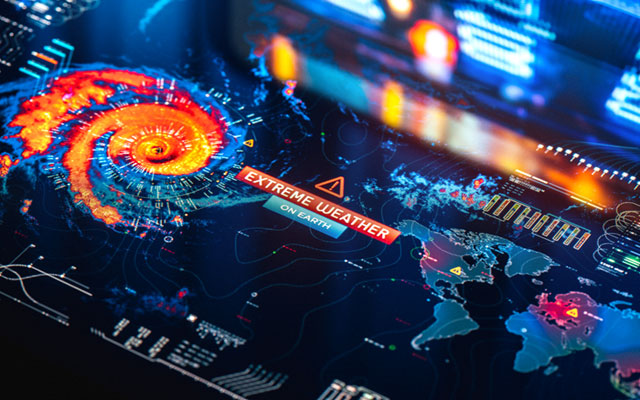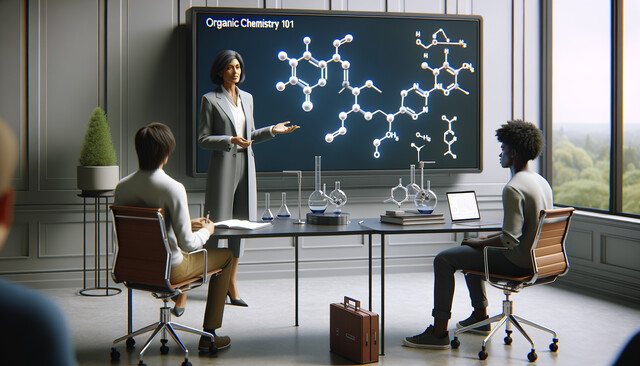Lesson 1. Chemical Bonding Basics: A Dive into Organic Chemistry
Key bonding types like ionic and covalent are dissected to illustrate how atoms form stable compounds, focusing on electron donation or sharing. The lesson uses examples and Lewis structures to depict these processes in molecules such as NaCl and N?.
Lesson 2. The Art of Drawing Organic Molecules
The representation of organic molecules can be streamlined by omitting certain atoms in diagrams and focusing on key structural components, which aids in distinguishing isomers. Concepts such as electron delocalization and the VSEPR model are essential for understanding molecule shape and behavior.
Lesson 3. The Fundamentals of Acids and Bases: A Comprehensive Exploration
Acids and bases can be defined through Arrhenius, Brønsted-Lowry, and Lewis models, each offering different criteria for classification based on ionization and electron interactions. The lesson delves into factors influencing acid/base strength, like bond strength and electron delocalization, to evaluate chemical reactions.
Lesson 4. Mastering IUPAC Nomenclature for Basic Organic Molecules
Utilizing the IUPAC nomenclature rules allows for precise and systematic identification of alkanes, which includes naming based on the longest carbon chain and the position of substituents. Cycloalkanes, when containing only single bonds, follow similar naming conventions with additional rules to accommodate their ring structures.
Lesson 5. Intramolecular Mechanics of Alkanes and Cycloalkanes
While alkanes and cycloalkanes are mostly inert due to balanced electron charge distribution, their physical properties like boiling points are influenced by van der Waals forces derived from induced dipoles. Functional groups mark the active sites within organic molecules, dictating how these compounds interact with one another chemically.
Lesson 6. The Essentials: Naming Alkyl Halides, Alcohols, Alkenes, Alkynes
The lesson introduces IUPAC nomenclature for key organic compounds like alkyl halides, alcohols, alkenes, and alkynes, emphasizing systematic naming approaches such as functional class and substitutive nomenclature. Through practice problems, learners become adept at identifying the longest carbon chains and correctly naming various functional groups.
Lesson 7. The Role of Hybrid Orbitals in Double and Triple Bonds
Through exploring the unique properties and synthesis of alkenes and alkynes, the lesson reveals insights into orbital arrangement and reactivity. Emphasis is placed on the structural rigidity due to ? bonds and how elimination reactions with bases or acids facilitate the creation of alkenes.
Lesson 8. Addition Reactions: Beyond Carbon-Carbon Double Bonds
This lesson covers the addition reactions in unsaturated hydrocarbons, highlighting the reverse nature compared to elimination reactions and the impact of conditions like catalysts or temperature. Detailed exploration of hydrogenation, electrophilic additions, and adherence to Markovnikov's rule showcases their transformative chemical nature.
Lesson 9. Nucleophilic Substitution Reactions Simplified
A nucleophilic substitution swaps a functional group in alky halides using electron-seeking compounds. Key topics include S N 1 and S N 2 mechanisms and evaluating nucleophile strength through reactivity and structure considerations.
Lesson 10. Understanding the Handedness of Molecules
In exploring the intricacies of stereochemistry, this lesson delves into chirality and its impact on molecular behavior, focusing on chiral molecules, enantiomers, and chirality centers. By recognizing chirality's role in optical activity, you'll apply tools like Fischer projections and the Cahn-Ingold-Prelog priority system to understand the complex nature of molecular three-dimensionality.
Lesson 11. Free Radicals and Their Role in Polymerization
In understanding polymerization and other reactions, free radicals serve as crucial intermediates due to their unpaired electrons and resultant reactivity. This lesson covers their formation and stabilization, highlighting examples such as methane chlorination to elucidate radical-driven reaction mechanisms.
Lesson 12. Benzene: The Quintessential Arene
Benzene, a unique aromatic hydrocarbon, exhibits stability due to delocalized electrons in its ring structure. Its derivatives can be systematically named using IUPAC rules, considering specific substitution patterns.
Lesson 13. Exploring the Reactions of Aromatic Compounds: An In-depth Guide to Electrophilic Substitution and Birch Reduction
Aromatic compounds display unique reactivity due to the reluctance toward typical addition reactions, opting instead for substitution to retain structure integrity. Benzene derivatives are synthesized via controlled mechanisms influenced by stability and resonance phenomena.
Lesson 14. Introduction to Spectroscopy Techniques: NMR, Mass Spectrometry, and IR
Chemists employ NMR spectroscopy, mass spectrometry, and IR spectroscopy to decipher unknown chemical compositions. These techniques rely on the physical principles of light interaction, magnetic spin states, and ionized particle mass.
Lesson 15. The Alchemy of Alcohols: Synthesis and Beyond
This lesson introduces the synthesis of alcohols by methods like reducing carbonyls and hydrating alkenes, moving beyond the classical focus on hydrocarbons. It further dives into alcohol reactions, unveiling transformations into alkenes, alkyl halides, and ethers, thus broadening the horizon of organic chemistry applications involving oxygen.
Lesson 16. Ethers & Epoxides Decoded
The lesson explores the conversion of alcohols to ethers via condensation, emphasizing the nuances of ether and epoxide structures. It also delves into the reactions they undergo, including synthesis and cleavage, while highlighting the distinctive reactivity of epoxides compared to ethers.
Lesson 17. The Role of Nucleophilic Addition in Carbonyl Chemistry
The lesson illuminates the structural similarities between aldehydes and ketones and explains how nucleophilic additions alter their chemistry. Factors like substituent group stability and steric hindrance greatly impact their hydration and energy release during reactions.
Lesson 18. The Chemistry of Enols, Enolates, and their Aldehyde and Ketone Counterparts
Focusing on enols and enolates, this lesson highlights their structural relationship with aldehydes and ketones, influencing the molecules' reactivity. Key reactions such as ?-halogenation and aldol condensation are framed by the pivotal role of ?-hydrogens' acidity and resonance stabilization.
Lesson 19. Diene Dynamics: Understanding Conjugated Systems
The interaction of conjugated dienes in chemical reactions exemplifies how combined functional groups differ from their isolated counterparts. This lesson elaborates on the peculiarities of conjugated dienes in the context of hydrogen halide additions and the intriguing Diels-Alder reaction mechanism.
Lesson 20. Exploring the Chemistry of ?-Dicarbonyls: Synthesis and Reactions Explained
This lesson explores the unique chemistry of ?-bicarbonyl compounds, characterized by two carbonyl groups separated by a single carbon, enabling special reactions such as acylation and alkylation. A notable synthesis involves the acylation of a ketone with an ester, forming ?-diketones, which can further undergo alkylation to form various products.
Lesson 21. Exploring the World of Carboxylic Acids and Their Fascinating Derivatives
Introducing carboxylic acids and derivatives, this lesson covers nomenclature and key reactions, featuring synthesis methods like Grignard carboxylation. The mechanism of acid-catalyzed esterification exemplifies the reactivity of these compounds.
Lesson 22. Amines: A Basic Introduction
In this lesson on nitrogen-containing compounds, we delve into amine characteristics, naming precedents, and typical reaction pathways. These compounds prove vital to understanding organic reactions, including hydrogen bonding and electron donation potential.
Lesson 23. Delving Into Aromatic Substitutions: From Aniline to Aryl Halides
Phenols and aryl halides take center stage in this lesson, illustrating the nuances of their properties and nomenclature in relation to the benzene ring. The content highlights the synthesis pathways and reaction mechanisms, underscoring the role of electron delocalization in phenol acidity and aryl halide formation.
Lesson 24. Carbohydrates: An Overview
The intricacies of carbohydrates, from their classification as ketoses or aldoses to their behavior in cyclic formations, unveil their role as vital biological molecules. Fischer projections serve as a tool to recognize structural properties and stereochemical variations within this molecular class.
Lesson 25. Exploring Lipids: A Gateway to Biochemistry
Lipids, being crucial for biological functions, possess a remarkable solubility in nonpolar solvents, unlike many organic molecules. This lesson reviews lipid varieties such as fats and waxes, serving to conclude the course with foundational insights into organic chemistry.
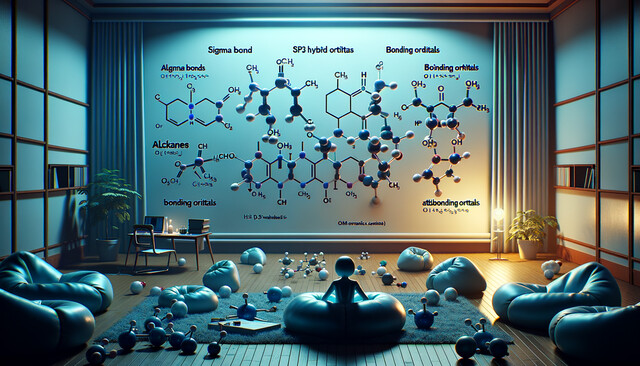
25 Hours average completion time
2.5 CEUs
25 Lessons
48 Exams & Assignments
28 Reference Files
Mobile Friendly
Last Updated December 2025

